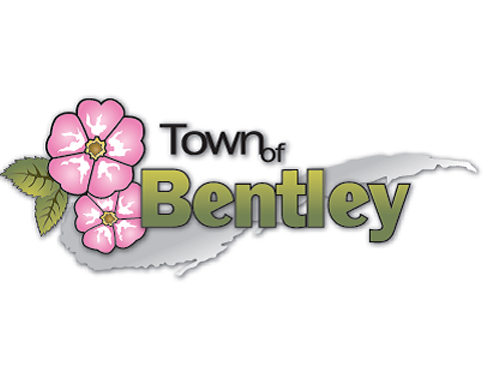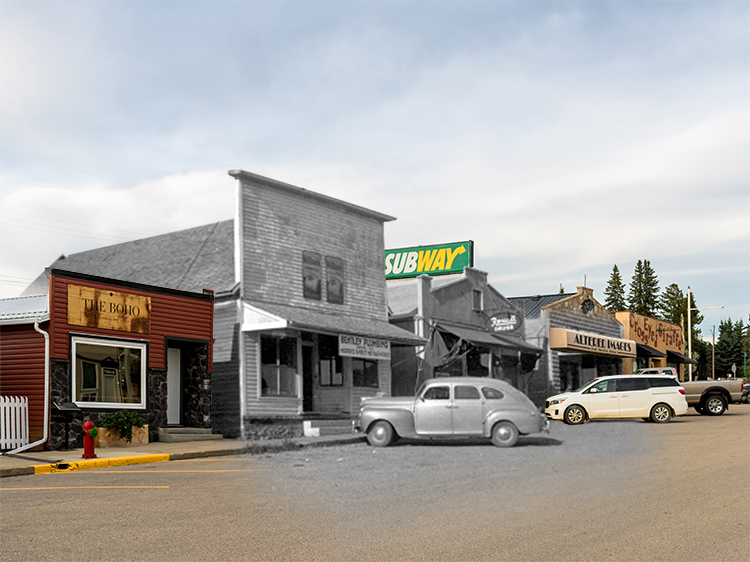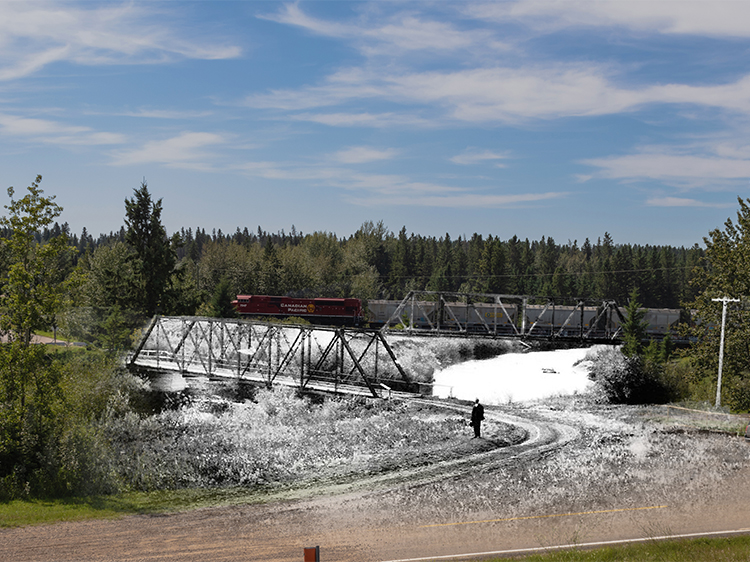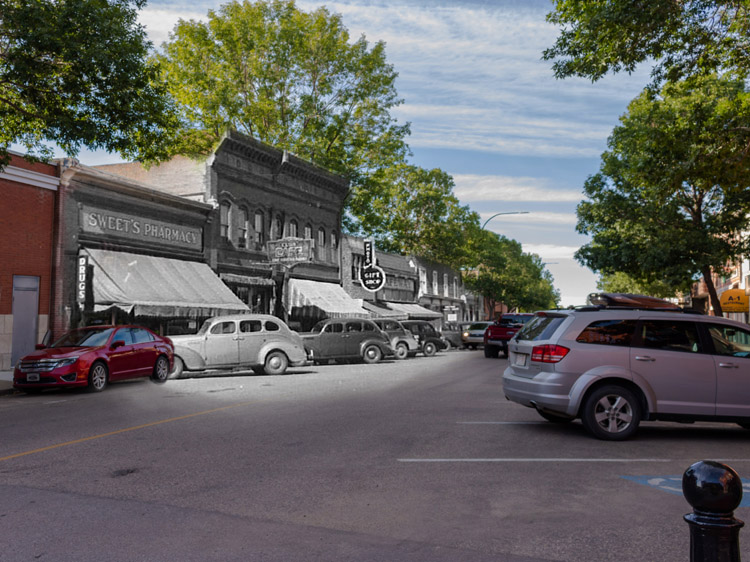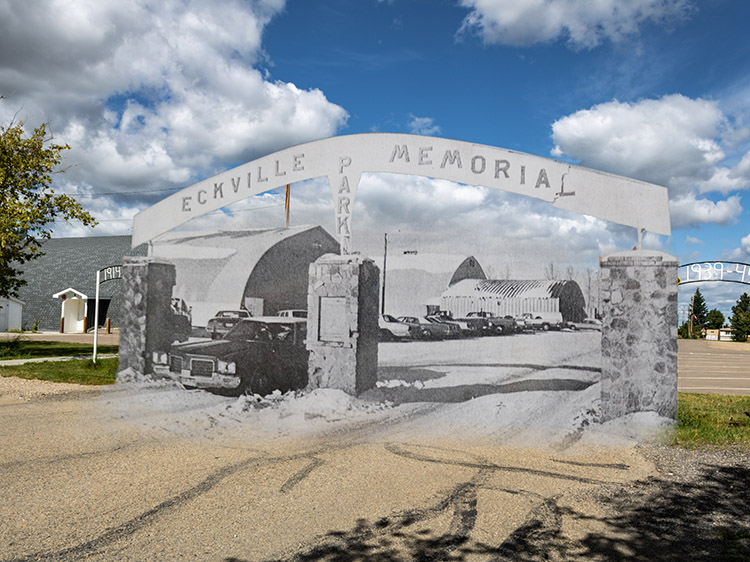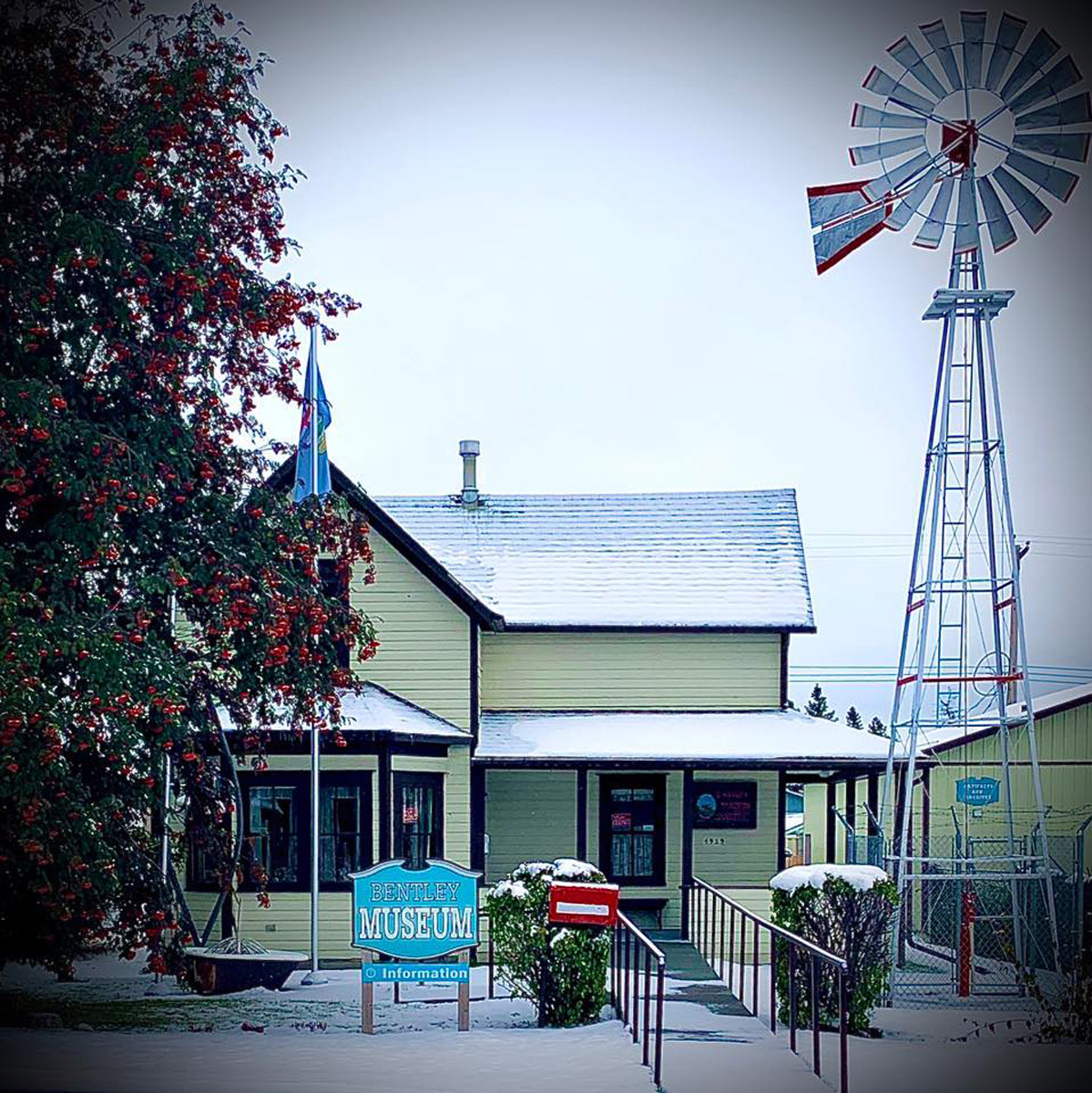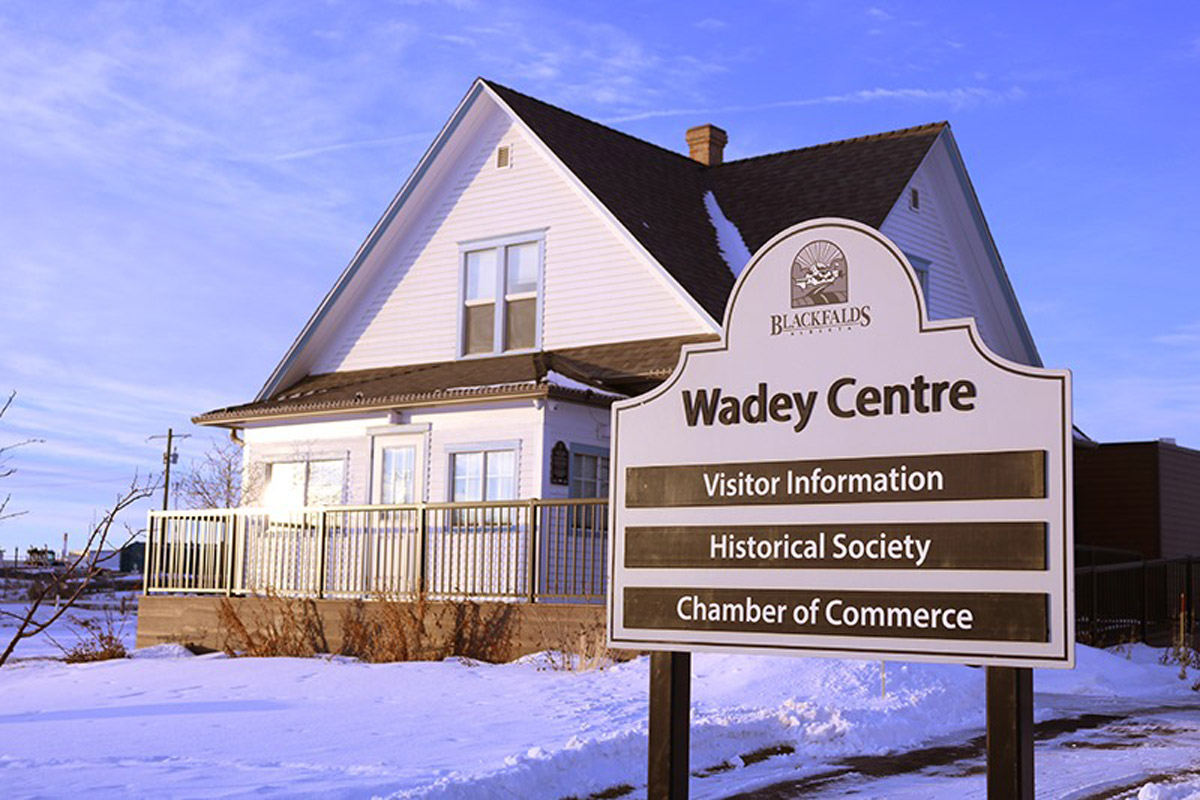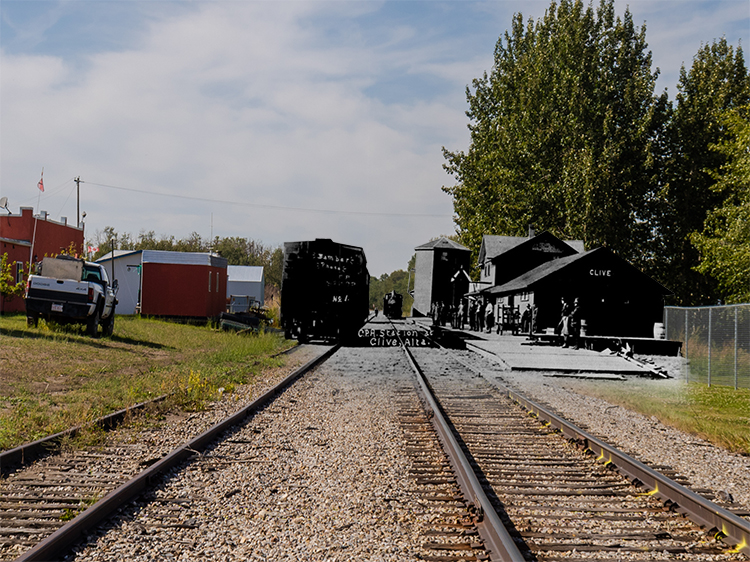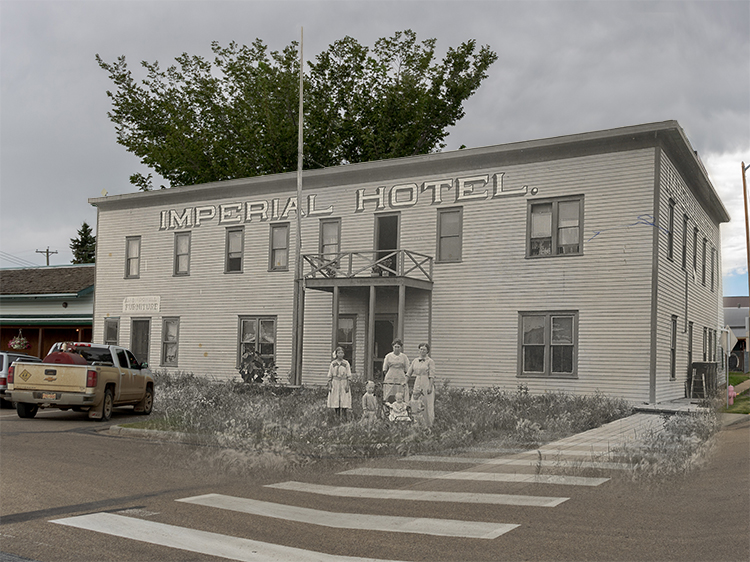In the shadow of the Sunset Hills, Bentley was founded by Major William McPherson and his sons in 1899, when they set up homesteads and laid out a townsite. In the years that followed the community prospered and grew rapidly, but a devastating fire in 1916 wiped out much of the south side of the main street. Rebuilding was swift, and the boulevard was widened into the broad distinctive boulevard that acts as the focus of community life today.
This project is a partnership with Lacombe Regional Tourism, the Town of Bentley, and the Bentley Museum.
We respectfully acknowledge that Bentley is on Treaty 6 territory, a traditional meeting grounds, gathering place, and traveling route to the Cree, Saulteaux, Blackfoot, Métis, Dene and Nakota Sioux. We respectfully acknowledge all the many First Nations, Métis, and Inuit whose footsteps have marked these lands for centuries.
Virtual Tours
Explore
Bentley
Then and Now Photos
Alexander Hotel
1909
Originally this was the site of the Alexander Hotel which burnt down in 1920. The next building was owned by Mr. Watson, who operated J.H. Watson General Store. The store changed hands a couple of times and when Mr. Brown was owner, the Witherells partnered with him until they moved up the street and opened the Red and White Store. The Browns lived in the building for a while and ran a real estate and insurance business. The building was sold and the owner changed his mind about opening a theatre, tore the building down and used the materials to build several buildings around town. The empty lot was sold and the Balmoral Café was born in 1960. The building has had many different owners and names but has remained a restaurant over 60 years. Today it is the Bentley Rose Café.
Atlas Lumber Company Ltd.
The Sam Smith Lumber Yard seems to have been the first lumber establishment here. In 1919, the Atlas Lumber Company bought out the Smith Lumber Company. Robert Stewart (Bob) was manager from 1919 to 1930, and in 1931, Claud Summers became manager. Mr. Plouffe took over after Mr. Summers retired in 1968.
Lumber came from local sawmills. Lumber prices fell in the late 1920’s and 1930’s. Rough lumber sold for approximately $10.00 per thousand board feet and planed lumber $12.00 to $15.00 per thousand board feet. In 1946, #1 cedar shingles sold at $5.25 for four bales or 100 square feet. At the same time birch hardwood flooring (thin type) sold for approximately 13 cents a square foot. In 1950 a spruce board 2 inches by 4 inches and 8 feet long sold for 22 cents. The manager’s house, built in approximately 1932 was situated on the east side of the lumberyard. Over the years many changes and improvements were made to the yard. When the Revelstoke Company bought out Atlas Lumber, the agent’s house was moved uptown to 49 th Ave and is the present home of Cora Knutson. The Atlas Lumber building was moved to the Charlie McNaught farm where it was used as a shop (The McNaught farm is presently owned by John Drost). At this time Claud Summers was the manager of Revelstoke. Revelstoke built a new modern store and lumber shed, which was managed by Rick Park from 1974 to 1978, and by Dale Hinkley for a short period until it closed. Reg Scott, a honey farmer, bought the Revelstoke building and saw shed in 1987 and moved it to his farm north of Bentley on Highway12. Dave Siebold purchased the Scott farm in December 1987 and renovated the Revelstoke building and lived in it until 1995 when he moved into his new house. After moving out of the Revelstoke building, he turned it into a wood working shop. Dave gutted the saw shed and made it into a garden storage shed.
Bentley Garage
The Bentley Garage was originally built by Frank (Cappy) & Percy Thorp after the 1916 fire destroyed their first garage. (Cappy got his nickname from being “Captain” of the “Seagull”)
They operated the North Star Oil agency and also sold Overland & Willys-Knight vehicles. Electricity was first generated here to service residents of Bentley. They used two large 12 cylinder stationary engines to generate 110 volt D.C. power which were later replaced by a large diesel unit. Power was turned on at dusk and cut off at 11:00 p.m. unless arrangements were made to have the power remain on for special events. If you wanted to stay up late it was back to the old oil lamp. On Mondays power was turned on in the daytime to accommodate the ladies to operate their washing machines and irons. Calgary power came to Bentley in 1935. Bentley Chiropractic Health Centre operates out of this building at present.
Bentley Meat Market
Originally the site of Damron’s Butcher Shop, opened in 1905 and destroyed by fire in 1916 and rebuilt. A bakery was added. In 1936, the butcher shop changed hands and in 1949, frozen food lockers were installed. It changed hands again in 1954, 1960 and 1964. The business grew and in 1976, the owners made the choice to sell rather than build a bigger building. The folks that ran the Mercantile ran the butcher shop as well until 1986. So the butcher shop operated in Bentley for 81 years. The building was left empty and eventually demolished. The present apartment building was built in 1986.
Blindman Valley Co-Op
In 1923, the basis for the Blindman Valley Co-Operative was formed. For the next half century it would be known as “The Hog Pool”, with headquarters in Bentley and serving a large geographic area. The high volume and quality of hogs allowed the agency to negotiate the best market price for their members. Over the years cattle and sheep would also be handled. By 1954 one million pigs had been marketed. Monday became know as “Hog Day” in Bentley, the time to bring hogs to market for shipping by train and for families to shop and socialize. In 1975 the agency ceased operations. Glen Wright managed the affairs of the Co-Operative from 1923 to 1968.
Garries Hardware Store
George Garries built his machine/blacksmith shop between 1900 and 1910. He became a Cockshutt/International Harvester agent and his son Paul worked with him in the repair shop. The shop burned down in 1921 and a new larger building was constructed on the same site as a hardware store with Imperial Oil distribution and gas pumps out front. Paul and a cousin, Russell ran the business after George passed away and it became a Marshall Wells store.
Paul and Russell retired and Russell's sons Gordon and Don continued and the building was added onto and remodeled in 1945. It became Link Hardware and still had the gas pumps. Don retired and Gordon and Son Richard operated as Home Hardware in the 1970s. Richard’s and wife, Leanne’s daughter, Pam reopened as a general hardware in 2006, closing again in 2013. This was the fifth generation of Garries to run the business. An antique store, called Mary’s Mercantile occupies the building at this time.
Little White School
The Little White School was built in 1903 or 1904.Previous to this school was held in a small log house owned by Guy Holmes.NW1/4 Sec 23. The site, (one and a half acres) of the Little White School was where Oxford School presently sits.
The school was to be 22 ft. wide and 38 ft. long. Among the finished purchases were blackboard cloth, hinges, putty bladders, latches and three dozen clothes hooks.The “Little White School” was moved back on the lot when the brick school was built. Eventually it was sold for $300.00 and moved to main street where it sits today. The building has had a few renovations and a number of different tenants and businesses. The “Little White School” is presently a modern bike shop, Bentley Cycle Inc.
Martin's Barber Shop
This building served various functions. Bertha Adamson operated a tea shop here. Helen Jaffray was among those who worked for her. Bertha married Albert Thorp in 1937and soon after, she and her mother-in-law, Lulu opened a ladies ready-to-wear shop in the building. This was a new venture for Lulu, whom had worked for many years in their bake and butcher shop across the street. Tom Pye moved his barbershop into this building. Adding living quarters and a basement in the 1950s. In 1961, Martin Schneider began his barbershop business here, and he and his wife, Inga made the suite in the rear of the building their home for the next ten years. Martin was “clipping away”for over 50 years. At the present time the building is a shop called BO-HO.
Methodist Church
In 1901 settlers brought 1 or 2 logs each to build a Methodist church on land donated by Major Wm. B McPherson. It became a club room when in 1911 a brick church was built. The building to the right in the picture was the manse where the minister & family lived. Behind the church was the barn where horses could be stabled. The Presbyterian & Methodist churches amalgamated in 1925 to form the United Church. The two buildings were removed in 1965 and a new church built. The church was sold and a kite shop operates out of the building.
Peterson Hardware & Massey Harris
Originally, this was the site of the Bill Peterson Hardware and Massey Harris dealership. This building was sold a couple of times and renovated to be a bakery with living quarters in the back. Over the years it was a Fabric Shop, a Sears outlet, sold Pic-a-Pop, and a Craft Shop. In 1989, new owners added sign painting and mending. In 2004, an accountant Chris Wiese purchased the property and opened an accounting office. Today, 2020, Benner’s Billards operates a business and the apartment is rented out.
Putland & Thorpe Building
The original Putland &Thorp building on this site was destroyed by fire in 1919. The gentlemen who owned this store were Archie Putland and Frank (Cappy) Thorp. Cappy was the first Mayor when Bentley was first incorporated into a village in 1915.
Saturday night was a special time for a trip to town. Folks arrived by teams or on saddle-horse which were then tied to the hitching rack out front. The Putland & Thorp building was replaced by the Bentley Co-Operative under the management of Mr. Bolton, and lastly by Chas MacDougall. The business was sold to Wm. A. Holmes in 1933 and operated as the Bentley Mercantile. In the early years supplies were brought in by train and picked up by horse and dray and delivered to the store. Later Mr, Holmes purchased a truck and would drive to Edmonton for supplies. Store merchants were well known for carrying credit for many customers during the 1930 depression years. Nostalgic memories include the smell of the freshly oiled floors, buying a slab of cheese cut from the bulk cheese cutter, seeing bananas hanging from the ceiling and the fact that Mr. Holmes would deliver groceries with his Chevrolet car in the Lockhart area where he could be greeted with an invitation to stay for a home cooked meal. The Holmes grocery building stands today as the popular “ Monkey Top Saloon”.
The Bentley Hotel
The land was purchased by Joe & Lawrence Morrisroe and construction started in 1940. Most of the labour was done with local help. The brothers, because of wartime problems, ran into financial trouble and they put the project on hold.
Eventually the Calgary Brewing Company came to their aid and, with the promise that they would serve their beer, arranged for a mortgage to be accessible. After the construction was complete they again ran into financial problems to furnish it. Afain the Brewing Co. came to their aid and the hotel opened on July 21, 1940. Without previous sales figures, the wartime ration quotas hit them hard on beer supplies. They were so limited that they only opened 3 days a week in the beginning. Beer sold for ten cents a glass, coffee at ten cents a cup and rooms rented for $2.00 per night. The Morrisroe’s sold the hotel in 1950 and there have been various owners since that time. At the present time 2020, the Bentley Hotel has expanded over the years and includes a modern liquor store and restaurant.
The Post Office
This building was originally owned by George Hopkins and housed the Bentley Post Office until a new one was built a block west. In the fifties and sixties, it was a men’s wear store. In 1967, Agnes Palmer purchased the building and operated a very successful beauty salon, that continued after Agnes retired. In 1999, the building was sold and became an antique store. In the years that followed a pool hall and a flower and gift shop were also in the building for a short time. The Cross Eyed Giraffe Restaurant opened here in 2008. It was operated by different people until closing in 2017 and remains closed at this time.
Union Bank
The Union Bank of Canada built this two story, full basement building which was equipped with two cement encased vaults, one on the main floor and one below. In 1923 the Bank of Montreal became the owners under management of W. B. Cairns, He occupied the living quarters upstairs.
The banks interior lent a dignified atmosphere with solid oak furniture, frosted glass enclosed managers office, barred teller's cage, with adjoining space for the tall shelf holding the huge ledger. Banking hours were the traditional 10-3 p.m. Investing in war bonds was very popular in the 1940’s. Interest rates were 8%.All transactions were hand posted. The Bank of Montreal was very supportive of community events and organizations and was involved with both the farming and village businesses. In 1978 the Bank of Montreal vacated these premises.
Williams & Weise Building
This building was used as a hotel & restaurant. It had a large hall on one side which was used for meetings, dances, chautauquas, movies, & other community activities. In the late 1930’s Don Wong, a very well respected Chinese gentleman, ran the café and rooms. When he became ill many young men volunteered to be tested for the blood transfusion which Mr. Wong needed. Memories of the café include that of a slot machine where you would put in a coin and in return would receive either a package of candy or sometimes money.
This was the previous site of the Williams Hotel with a feed & livery business and also of the Cottage Home Hotel. In 1959 Louis Wine purchased the Williams and Wiese building and from 1959 to 1961 did extensive renovations. Louis lowered the roof by 4 feet. He made 2 apartments upstairs and 2 stores downstairs and a shop in the back. Today 2020 the businesses downstairs are a Beauty Salon and Queen Bee, a ladies wear and accessories.



